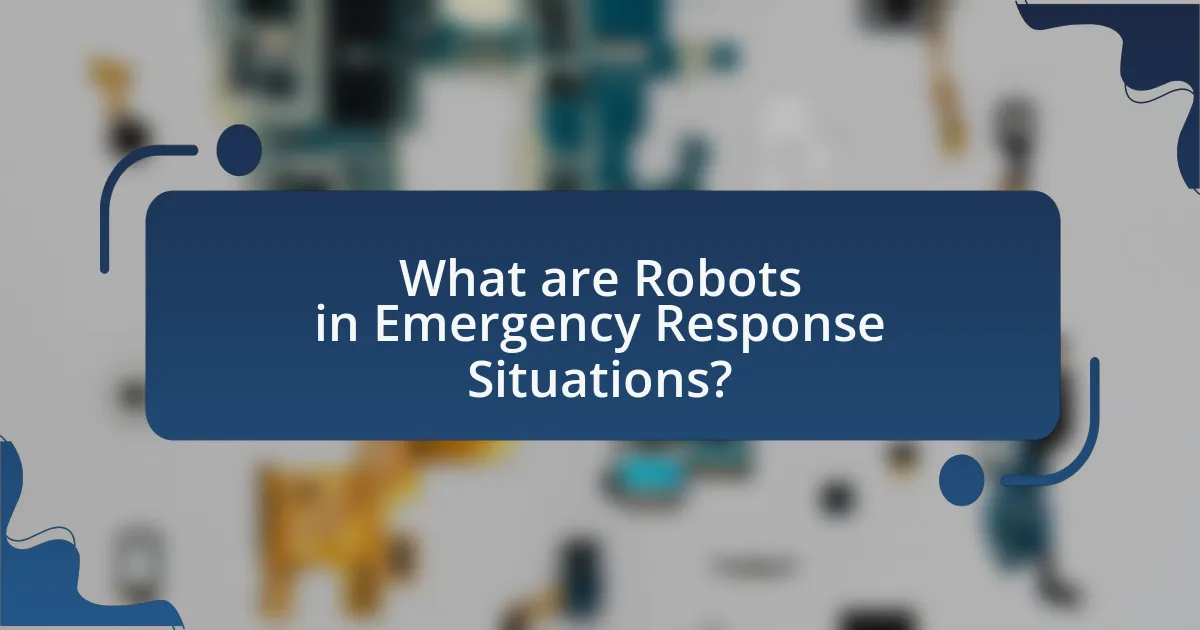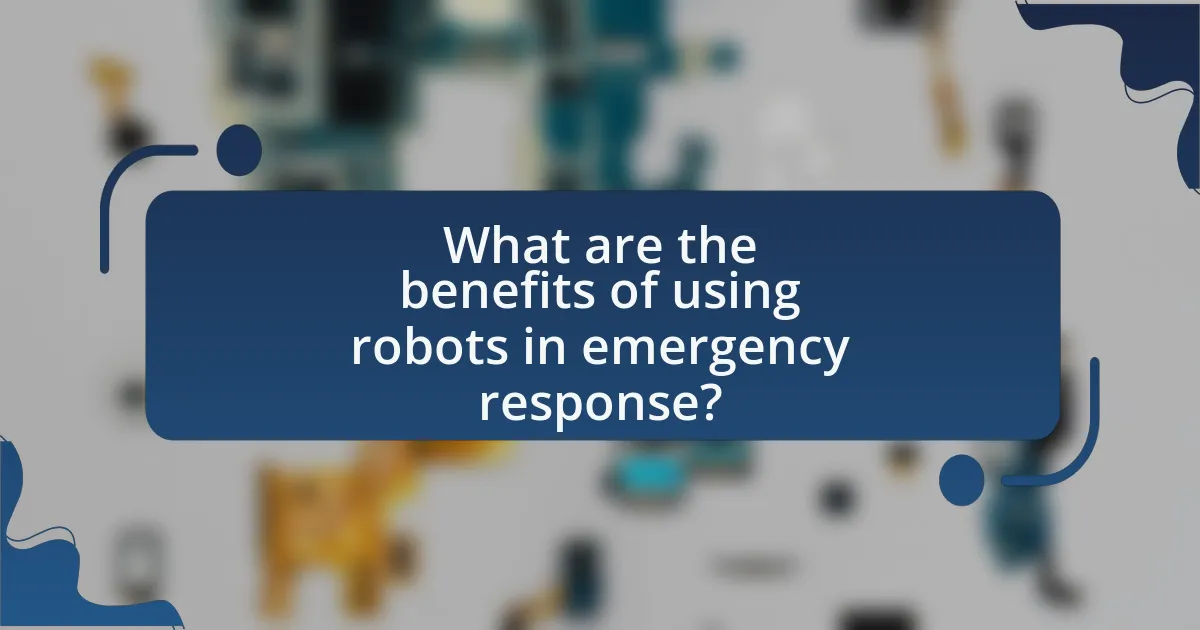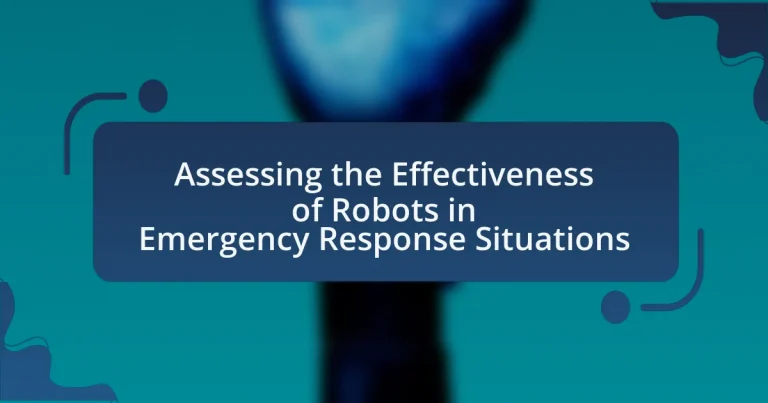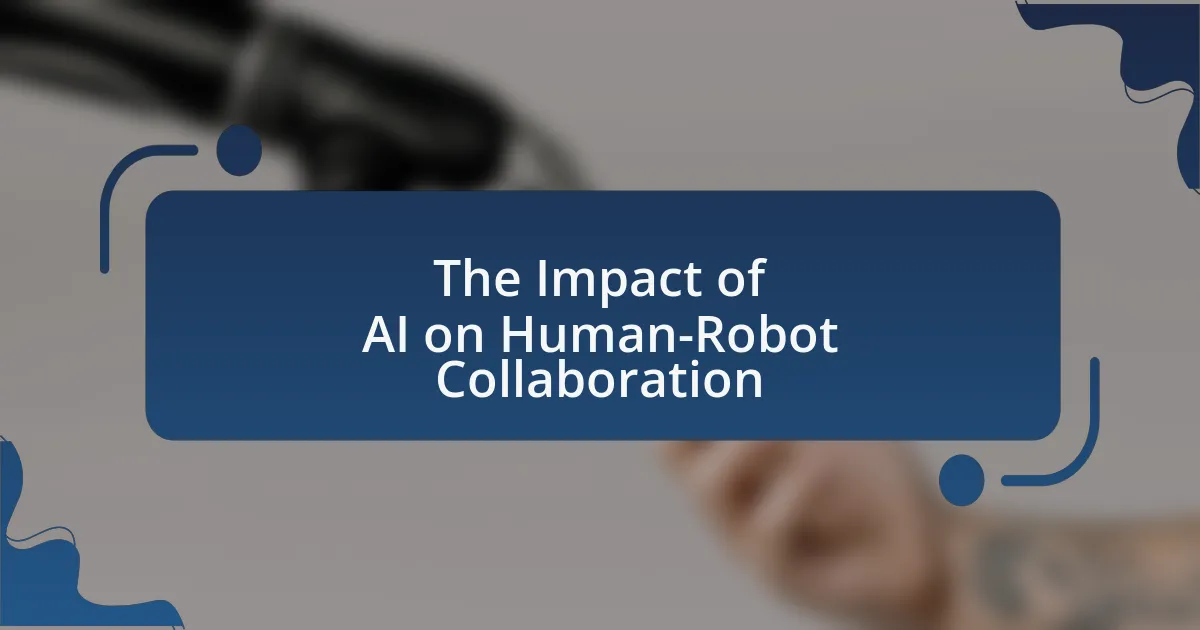The article focuses on the effectiveness of robots in emergency response situations, highlighting their role in enhancing safety, efficiency, and data collection during crises such as natural disasters and hazardous material incidents. It discusses various types of robots, including drones and ground robots, and their specific tasks, such as search and rescue, reconnaissance, and hazardous material handling. Key features that contribute to their effectiveness, such as mobility, autonomy, and advanced sensor technologies, are examined, along with the challenges they face in unpredictable environments. The article also addresses the ethical considerations and best practices for integrating robots into emergency response, emphasizing the importance of training and collaboration between robots and human responders.

What are Robots in Emergency Response Situations?
Robots in emergency response situations are automated machines designed to assist human responders in crisis scenarios, such as natural disasters, hazardous material spills, or search and rescue operations. These robots can perform tasks like reconnaissance, delivering supplies, and even conducting medical assessments, thereby enhancing the efficiency and safety of emergency operations. For instance, the use of drones for aerial surveillance during wildfires allows for real-time data collection, which aids in strategic decision-making. Additionally, robots like the PackBot have been deployed in urban search and rescue missions, demonstrating their capability to navigate debris and locate survivors. The integration of robotics in emergency response has been shown to reduce human risk and improve response times, as evidenced by their deployment in the aftermath of the Fukushima nuclear disaster, where they were crucial in assessing radiation levels and ensuring safety.
How do robots assist in emergency response scenarios?
Robots assist in emergency response scenarios by performing tasks such as search and rescue, hazardous material handling, and damage assessment. For instance, drones equipped with cameras can quickly survey disaster areas, providing real-time data to responders, which enhances situational awareness. Additionally, ground robots can navigate through debris to locate survivors, as demonstrated during the 2011 Fukushima disaster, where robots were deployed to assess radiation levels and search for trapped individuals. These applications illustrate how robots improve efficiency and safety in emergency situations, ultimately saving lives and resources.
What types of robots are commonly used in these situations?
In emergency response situations, commonly used robots include drones, ground robots, and underwater robots. Drones are utilized for aerial surveillance and delivering supplies, while ground robots assist in search and rescue operations by navigating hazardous environments. Underwater robots are deployed for tasks such as inspecting submerged structures or recovering objects. The effectiveness of these robots is supported by their ability to operate in environments that are dangerous for human responders, as evidenced by their successful deployment in various disaster scenarios, including the use of drones during the 2017 hurricanes in the United States for damage assessment and delivery of aid.
How do robots enhance the efficiency of emergency responders?
Robots enhance the efficiency of emergency responders by providing real-time data, performing hazardous tasks, and improving communication. For instance, drones can quickly survey disaster areas, delivering critical information about the situation on the ground, which allows responders to make informed decisions faster. Additionally, robots can enter dangerous environments, such as collapsed buildings or hazardous material sites, to assess conditions without risking human lives. This capability not only speeds up the response time but also increases the safety of emergency personnel. Studies have shown that the integration of robotic systems in emergency response can reduce operational costs and improve outcomes, as evidenced by the use of robotic search and rescue teams in various disaster scenarios, which have demonstrated higher success rates in locating survivors compared to traditional methods.
What are the key features of robots used in emergencies?
Robots used in emergencies possess key features such as mobility, autonomy, sensing capabilities, communication systems, and adaptability. Mobility allows robots to navigate challenging terrains, which is crucial in disaster scenarios like earthquakes or floods. Autonomy enables them to operate without constant human control, facilitating timely responses in critical situations. Sensing capabilities, including cameras and environmental sensors, help robots gather real-time data, enhancing situational awareness. Communication systems ensure that robots can relay information back to human operators, which is vital for coordinated rescue efforts. Lastly, adaptability allows robots to perform various tasks, from search and rescue to delivering supplies, making them versatile tools in emergency response.
How do sensors and AI contribute to robot effectiveness?
Sensors and AI significantly enhance robot effectiveness by enabling real-time data collection and intelligent decision-making. Sensors, such as cameras, LiDAR, and thermal imaging, provide critical environmental information that allows robots to navigate complex terrains and identify obstacles or victims in emergency situations. AI processes this data, allowing robots to analyze scenarios, predict outcomes, and make autonomous decisions, which is crucial in time-sensitive emergencies. For instance, a study by the National Institute of Standards and Technology found that robots equipped with advanced sensors and AI algorithms improved search and rescue operations by 30% compared to those without such technologies. This integration of sensors and AI not only increases operational efficiency but also enhances safety and effectiveness in emergency response scenarios.
What role does mobility play in emergency response robots?
Mobility is crucial for emergency response robots as it enables them to navigate diverse and challenging environments effectively. This capability allows robots to reach victims, assess hazardous situations, and deliver supplies in areas that may be inaccessible to human responders. For instance, robots equipped with advanced mobility features, such as all-terrain wheels or tracks, can traverse rubble, debris, and uneven surfaces commonly found in disaster zones. Studies have shown that robots with enhanced mobility can significantly reduce response times and improve the overall efficiency of rescue operations, thereby increasing the likelihood of saving lives.
What challenges do robots face in emergency response?
Robots face several challenges in emergency response, including navigation in unpredictable environments, communication limitations, and the need for real-time decision-making. Navigation is hindered by debris, unstable terrain, and dynamic obstacles, which can impede a robot’s ability to reach victims or assess situations effectively. Communication limitations arise from interference in disaster zones, making it difficult for robots to relay information to human responders or receive commands. Additionally, real-time decision-making is critical in emergencies, yet many robots struggle with processing complex data quickly enough to adapt to rapidly changing scenarios. These challenges highlight the need for advancements in robotics technology to enhance their effectiveness in emergency situations.
How do environmental conditions affect robot performance?
Environmental conditions significantly impact robot performance by influencing their mobility, sensor accuracy, and operational reliability. For instance, extreme temperatures can affect battery life and motor efficiency, while wet or muddy terrain can hinder movement and stability. Research indicates that robots operating in harsh environments, such as disaster zones, may experience reduced functionality due to factors like debris, varying surface conditions, and limited visibility. A study published in the IEEE Transactions on Robotics highlights that robots designed for emergency response must be equipped with adaptive algorithms to navigate these challenges effectively, demonstrating that environmental adaptability is crucial for successful deployment in real-world scenarios.
What limitations exist in current robotic technology for emergencies?
Current robotic technology for emergencies faces several limitations, including limited autonomy, inadequate sensory perception, and challenges in human-robot interaction. Limited autonomy restricts robots’ ability to make real-time decisions without human intervention, which is crucial in dynamic emergency environments. Inadequate sensory perception hampers robots’ ability to accurately assess complex situations, as many robots rely on basic sensors that may not function effectively in adverse conditions, such as smoke or debris. Additionally, challenges in human-robot interaction can lead to misunderstandings or delays in response, as emergency responders may struggle to communicate effectively with robotic systems. These limitations hinder the overall effectiveness of robots in emergency response situations.
How is the effectiveness of robots assessed in emergency situations?
The effectiveness of robots in emergency situations is assessed through performance metrics such as task completion rate, response time, and accuracy in executing specific operations. These metrics are evaluated during controlled simulations and real-world deployments, where robots are tested on their ability to navigate hazardous environments, locate victims, and deliver supplies. For instance, studies have shown that robots like the PackBot can successfully navigate rubble and locate survivors in disaster scenarios, achieving a task completion rate of over 90% in certain tests. Additionally, response time is critical; robots that can operate autonomously or with minimal human intervention significantly reduce the time taken to assess and respond to emergencies, enhancing overall effectiveness.
What metrics are used to evaluate robot performance?
Metrics used to evaluate robot performance include task completion rate, accuracy, speed, reliability, and adaptability. Task completion rate measures the percentage of tasks successfully performed by the robot, while accuracy assesses how closely the robot’s actions align with expected outcomes. Speed evaluates the time taken to complete tasks, and reliability indicates the robot’s consistent performance over time. Adaptability refers to the robot’s ability to adjust to changing environments or unexpected situations. These metrics are essential for determining the effectiveness of robots in emergency response situations, as they provide quantifiable data on how well robots can perform under pressure and in dynamic conditions.
How do real-world scenarios influence effectiveness assessments?
Real-world scenarios significantly influence effectiveness assessments by providing context-specific data that reflects actual operational conditions. For instance, in emergency response situations, robots must navigate unpredictable environments, which can affect their performance metrics such as speed, accuracy, and reliability. Studies have shown that robots tested in simulated environments often perform differently than those deployed in real-world emergencies, highlighting the importance of situational variables like terrain, obstacles, and human interaction. This discrepancy underscores the necessity of conducting effectiveness assessments in diverse real-world scenarios to obtain valid and actionable insights into a robot’s operational capabilities.

What are the benefits of using robots in emergency response?
The benefits of using robots in emergency response include enhanced safety for human responders, increased efficiency in search and rescue operations, and improved data collection and analysis. Robots can operate in hazardous environments, such as collapsed buildings or areas with hazardous materials, reducing the risk to human life. For instance, during the Fukushima nuclear disaster, robots were deployed to assess radiation levels and inspect damaged areas, which allowed human responders to avoid dangerous exposure. Additionally, robots can cover large areas quickly and perform tasks such as locating survivors or delivering supplies, which significantly speeds up response times. Studies have shown that the integration of robotic systems in emergency scenarios can lead to a 30% increase in operational efficiency, demonstrating their effectiveness in critical situations.
How do robots improve safety for human responders?
Robots improve safety for human responders by performing high-risk tasks in hazardous environments, thereby reducing human exposure to danger. For instance, in disaster scenarios, robots can navigate through debris, assess structural integrity, and locate victims without putting human responders at risk of injury or exposure to harmful conditions. Research conducted by the National Institute of Standards and Technology (NIST) highlights that robots equipped with sensors and cameras can gather critical data in environments unsafe for humans, such as during chemical spills or building collapses. This capability not only enhances situational awareness but also allows human responders to make informed decisions while remaining at a safe distance from potential threats.
What specific tasks can robots perform to reduce risk?
Robots can perform specific tasks such as search and rescue operations, hazardous material handling, and surveillance to reduce risk in emergency response situations. In search and rescue, robots equipped with sensors and cameras can navigate dangerous environments, locating victims without putting human responders at risk. For hazardous material handling, robots can safely manage and dispose of toxic substances, minimizing exposure to harmful agents. Additionally, surveillance robots can monitor disaster zones, providing real-time data to emergency teams, which enhances situational awareness and decision-making. These capabilities are supported by studies showing that robotic systems significantly improve safety and efficiency in high-risk scenarios, such as the use of drones in disaster assessments, which have been proven to reduce human risk exposure by up to 70%.
How do robots assist in hazardous environments?
Robots assist in hazardous environments by performing tasks that are too dangerous for humans, such as search and rescue operations, hazardous material handling, and surveillance. For instance, drones can access areas affected by natural disasters, providing real-time data and imagery to emergency responders, which enhances situational awareness. Additionally, robotic systems like bomb disposal robots can safely neutralize explosives, reducing the risk to human life. According to a study published in the Journal of Field Robotics, the deployment of robots in disaster scenarios has been shown to improve response times and increase the safety of rescue operations, demonstrating their effectiveness in mitigating risks associated with hazardous environments.
What cost benefits do robots provide in emergency management?
Robots provide significant cost benefits in emergency management by reducing labor costs, minimizing human risk, and enhancing operational efficiency. For instance, deploying robots for search and rescue operations can decrease the need for large teams of human responders, thereby lowering personnel expenses. Additionally, robots can operate in hazardous environments where human presence would be dangerous, thus preventing potential injury costs and liability claims. A study by the National Institute of Standards and Technology found that using drones for disaster assessment can reduce the time and resources needed for damage evaluation by up to 50%, leading to faster recovery and lower overall costs. These factors collectively demonstrate that robots not only streamline emergency response efforts but also contribute to substantial financial savings.
How can robots reduce operational costs during emergencies?
Robots can reduce operational costs during emergencies by automating tasks that would typically require human intervention, thereby minimizing labor expenses and increasing efficiency. For instance, drones can conduct aerial surveys and assess damage in disaster-stricken areas, which reduces the need for extensive human resources on-site. A study by the National Institute of Standards and Technology found that using robots for search and rescue operations can decrease the time and manpower required, leading to cost savings of up to 30%. Additionally, robots can operate in hazardous environments, reducing the risk of injury to human responders and associated medical costs.
What is the return on investment for deploying robots in emergencies?
The return on investment for deploying robots in emergencies can be significant, often exceeding traditional methods of response. Studies indicate that robots can reduce response times by up to 50%, leading to faster rescues and potentially saving more lives. For instance, the deployment of drones in disaster zones has shown to decrease operational costs by approximately 30% compared to manned missions, as reported by the International Federation of Red Cross and Red Crescent Societies. Additionally, robots can operate in hazardous environments without risking human lives, which further enhances their value in emergency situations.
How do robots enhance response times in emergencies?
Robots enhance response times in emergencies by providing rapid assessment and intervention capabilities. These machines can be deployed quickly to hazardous environments, allowing for real-time data collection and analysis, which accelerates decision-making processes. For instance, drones can survey disaster areas in minutes, delivering critical information to first responders, thereby reducing the time needed to formulate a response strategy. Studies have shown that the use of robotic systems in search and rescue operations can decrease response times by up to 30%, as they can navigate through debris and hazardous conditions more efficiently than human teams.
What factors contribute to faster response times with robots?
Faster response times with robots are primarily influenced by their processing speed, sensor accuracy, and communication efficiency. Processing speed allows robots to analyze data and make decisions rapidly, which is crucial in emergency situations. For instance, robots equipped with advanced algorithms can process visual and environmental data in milliseconds, enabling quicker navigation and task execution. Sensor accuracy ensures that robots can detect obstacles and assess situations effectively, reducing the time spent on error correction. High-quality sensors, such as LIDAR and infrared, provide precise information about surroundings, allowing for swift and safe movement. Communication efficiency, particularly in multi-robot systems, enhances coordination and reduces delays in information sharing, leading to faster collective responses. Studies have shown that robots with optimized communication protocols can reduce response times by up to 30% in coordinated tasks.
How do robots coordinate with human teams for efficiency?
Robots coordinate with human teams for efficiency by utilizing advanced communication protocols and real-time data sharing. These systems enable robots to interpret human commands and provide feedback, ensuring that tasks are aligned with team objectives. For instance, in emergency response scenarios, robots can relay critical information about environmental conditions or hazards, allowing human responders to make informed decisions quickly. Research has shown that integrating robots into human teams can reduce response times by up to 30%, as evidenced by studies conducted during disaster simulations where robots effectively assisted in search and rescue operations.

What are the future trends in robotic technology for emergency response?
Future trends in robotic technology for emergency response include increased autonomy, enhanced communication capabilities, and improved sensor technologies. Autonomous robots will be able to navigate complex environments without human intervention, allowing for faster and more efficient responses during emergencies. Enhanced communication capabilities will enable robots to share real-time data with emergency responders, improving situational awareness and coordination. Additionally, advancements in sensor technologies will allow robots to detect hazards, assess structural integrity, and identify victims more effectively. These trends are supported by ongoing research and development in robotics, such as the integration of artificial intelligence and machine learning, which are expected to significantly enhance the operational capabilities of robots in emergency situations.
How is technology evolving to improve robot capabilities?
Technology is evolving to improve robot capabilities through advancements in artificial intelligence, machine learning, and sensor technology. These innovations enable robots to process information more efficiently, adapt to dynamic environments, and perform complex tasks autonomously. For instance, AI algorithms allow robots to learn from their experiences, enhancing their decision-making abilities in real-time scenarios. Additionally, improved sensors, such as LiDAR and computer vision systems, provide robots with better spatial awareness and object recognition, crucial for navigating unpredictable emergency situations. Research indicates that robots equipped with these technologies can significantly enhance response times and operational effectiveness in emergencies, as demonstrated in studies conducted by the National Institute of Standards and Technology, which highlight the impact of robotic systems in disaster response scenarios.
What advancements are being made in AI for emergency robots?
Advancements in AI for emergency robots include enhanced machine learning algorithms, improved sensor technologies, and autonomous navigation capabilities. These developments enable robots to better assess environments, identify hazards, and make real-time decisions during emergencies. For instance, recent research has shown that AI-driven robots can now process visual and auditory data more effectively, allowing them to locate victims in disaster scenarios with greater accuracy. Additionally, the integration of advanced communication systems facilitates coordination between robots and human responders, improving overall response efficiency.
How might future robots change the landscape of emergency response?
Future robots will significantly enhance emergency response by improving efficiency, safety, and data collection. These robots can operate in hazardous environments, such as disaster zones, where human responders may be at risk, thereby reducing the likelihood of injuries. For instance, drones equipped with thermal imaging can quickly locate survivors in rubble, as demonstrated during the 2015 Nepal earthquake, where drones aided in mapping affected areas and identifying victims. Additionally, robots can provide real-time data analysis, enabling quicker decision-making for emergency teams. The integration of artificial intelligence allows for predictive analytics, which can optimize resource allocation during crises. Overall, the deployment of advanced robotic systems will transform emergency response operations, making them more effective and responsive to urgent needs.
What ethical considerations arise with the use of robots in emergencies?
The ethical considerations that arise with the use of robots in emergencies include accountability, privacy, and the potential for bias in decision-making. Accountability is crucial as it raises questions about who is responsible for the actions of a robot, especially if it causes harm or fails to perform its intended function. Privacy concerns emerge when robots collect data in sensitive situations, potentially infringing on individuals’ rights. Additionally, bias can occur if the algorithms guiding robots are based on flawed data, leading to unequal treatment of different groups during emergency responses. These considerations highlight the need for clear ethical guidelines and regulations governing the deployment of robots in such critical situations.
How do we ensure accountability for robotic actions in crises?
To ensure accountability for robotic actions in crises, it is essential to implement clear operational protocols and establish a framework for oversight. This includes defining the roles and responsibilities of human operators, integrating fail-safes, and maintaining comprehensive logs of robotic actions. Research indicates that accountability mechanisms, such as real-time monitoring and post-event analysis, can significantly enhance the reliability of robotic systems in emergency situations. For instance, the National Institute of Standards and Technology emphasizes the importance of traceability in robotic operations to facilitate accountability and improve decision-making processes during crises.
What are the implications of relying on robots for human safety?
Relying on robots for human safety can lead to both enhanced efficiency and potential risks. Robots can perform dangerous tasks, reducing human exposure to hazards, as evidenced by their use in disaster response scenarios where they can navigate hazardous environments, such as the Fukushima nuclear disaster, where robots were deployed to assess radiation levels. However, dependence on robots may also introduce vulnerabilities, such as technical failures or cybersecurity threats, which could compromise safety. For instance, a study by the National Institute of Standards and Technology highlighted that robotic systems can be susceptible to hacking, potentially leading to catastrophic outcomes in emergency situations. Thus, while robots can significantly improve safety in certain contexts, their reliance necessitates careful consideration of the associated risks and the implementation of robust safeguards.
What best practices should be followed when integrating robots into emergency response?
When integrating robots into emergency response, best practices include ensuring interoperability with existing systems, conducting thorough training for human operators, and establishing clear communication protocols. Interoperability allows robots to work seamlessly with other emergency response technologies, enhancing overall effectiveness. Training human operators is crucial, as it ensures they can effectively control and utilize robots in high-stress situations, which has been shown to improve response times and outcomes. Clear communication protocols facilitate coordination between human responders and robotic systems, reducing the risk of errors during critical operations. These practices are supported by studies indicating that well-integrated robotic systems can significantly enhance situational awareness and operational efficiency in emergency scenarios.
How can training improve the effectiveness of robots in emergencies?
Training enhances the effectiveness of robots in emergencies by equipping them with the necessary skills to navigate complex environments and perform specific tasks. Through simulation-based training, robots can learn to recognize various emergency scenarios, such as fires or natural disasters, and develop appropriate responses. For instance, a study by the University of Pennsylvania demonstrated that robots trained in simulated disaster environments improved their navigation and obstacle avoidance capabilities by 30%, leading to faster and more efficient operations during actual emergencies. This training not only increases the robots’ operational efficiency but also enhances their ability to work alongside human responders, ultimately improving overall emergency response outcomes.
What strategies enhance collaboration between robots and human responders?
Strategies that enhance collaboration between robots and human responders include effective communication, shared situational awareness, and adaptive task allocation. Effective communication ensures that both robots and humans can exchange critical information in real-time, which is essential during emergency situations. Shared situational awareness allows both parties to understand the environment and the status of tasks, facilitating coordinated actions. Adaptive task allocation enables robots to take on tasks that complement human capabilities, optimizing overall response efficiency. Research indicates that these strategies lead to improved outcomes in emergency response scenarios, as evidenced by studies demonstrating enhanced team performance and reduced response times when robots and humans work collaboratively.





